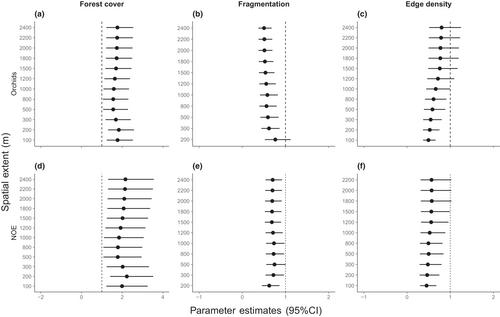Human-driven landscape processes such as habitat loss and fragmentation act on biodiversity, but their effects are mediated by the spatial scale at which they are observed. We aim to analyse the scale-of-effects (direction and spatial extent) of landscape-scale processes that best explain species richness and abundance across epiphyte communities.
Neotropics, Northern Andes, Colombia, Eastern cordillera.
Vascular epiphytes, Orchidaceae.
We used field data to unravel the scale-of-effect of three landscape processes—habitat loss (forest cover), fragmentation (number of patches) and edge effects (edge density)—on epiphyte biodiversity. Vascular epiphytes were sampled in the understorey across 141 plots within 23 Andean forests in the eastern Colombian cordillera We focused on the community-level responses (species richness and total abundance) of the hyperdiverse vascular epiphyte communities using generalized linear mixed models to quantify the direction and the spatial extent of the scale-of-effects.
Habitat loss and edge effects act at fine spatial extents (scale-of-effects = 200 m), predicting low species richness and abundance across groups. Likewise, fragmentation negatively impacts communities, but operates at larger spatial extents (scale-of-effects = 2000–2400 m radius). The detection of these effects is contingent upon the spatial extent and specific landscape processes involved. Models of habitat loss within a spatial extent of 800–1500 m (large confidence intervals), fragmentation below 300 m, and edge effects above 800 m show weak statistical support (marginal r2 = 0.02–0.1). Thus, the impacts of these landscape processes may be overlooked if studied at inadequate spatial extents.
We showed that habitat loss, fragmentation and edge effects all play a negative role on understorey epiphytic communities, but their detectability is scale dependant. The scale-of-effects can assist landscape designs that are beneficial for epiphytic communities, by preserving forest cover, and reducing fragmentation and exposure to edge effects at small scales (200–300 m). Conversely, landscape-scale actions directed at reducing habitat loss and fragmentation function at larger spatial extents (>2000 m). Selecting a priori or inadequate spatial extents of analysis can obscure the detectability of landscape processes.



